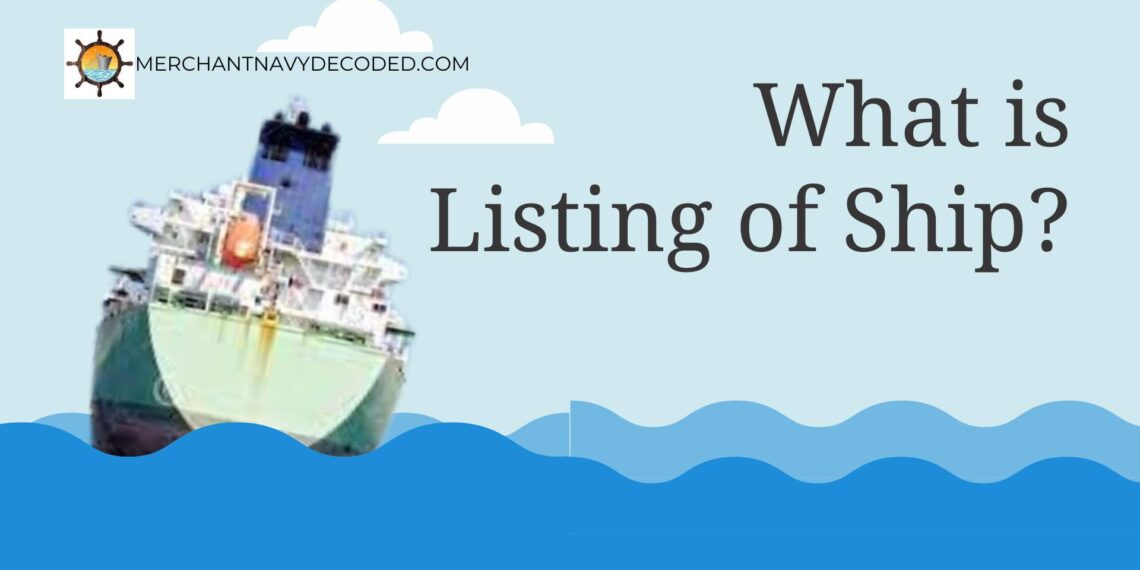Listing of Ship & Angle of List
Overview
When a large ship is on the water and everything is just right, it floats evenly. But sometimes, things aren’t perfect, and one side of the ship might be heavier, maybe because there’s more stuff loaded on that side. When this happens, the ship leans to one side, and this leaning is known as a “Listing of Ship.”
What is the Listing of Ship?

A list happens when a ship leans to one side because its center of gravity isn’t right in the middle. For a ship to float evenly, it needs the upward push of the water and the downward pull of its weight to be in perfect balance.
In other words, for a ship to be in static equilibrium:
1) The force of buoyancy must equal the force of gravity.
2) The COB & COG of the ship must be in a vertical line.

If the COG is moved out of the ship’s center line, due to uneven loading or discharging or a transverse shift of weights aboard.
1) The ship will sink or rise as necessary until the force of buoyancy equalizes the force of gravity.
2) The forces of buoyancy and gravity will form a couple which will cause the ship to incline until the COB comes vertically below the COG.

GG1 represents how much the ship’s center of gravity moves sideways. This sideways shift, along with the push and pull of water and weight, makes the ship tilt. As it tilts, the point where the ship floats best moves toward the lower side. When this point lines up directly under the shifted center of gravity, the ship stops tilting and finds its balance again. The tilt angle at this moment is what we call the “Angle of List.”
Learn more about the technical aspects of ship stability with our blog on Loadline of Ship.
Formula for Angle of List
Tanθ = GG1/GM
Where, θ = the angle of the list
GG1 = transverse shift of G
GM = fluid GM before listing
You can get GG1 with this formula GG1 = (d*w)/W
Once you substitute the formula of GG1 in the formula of Angle of List, then you will get;
Tanθ = (d*w)/W.GM
Where, d*w = the final listing moment in tonne-meters
W = the final displacement in tonnes
GM = the final fluid GM in meters
To Calculate the Angle of the List
The following order of work is suggested
1) Find the final listing moment (d*w)
2) Find the final displacement (W)
3) Find the final fluid GM
4) Apply the list formula Tanθ = (d*w)/(W.GM)
Conclusion
When cargo isn’t loaded evenly on a ship, it can make the ship lean to one side because the center of gravity shifts. To fix this, the cargo needs to be moved around so it’s spread out evenly. This helps keep the ship stable and safe for everyone on board.
Angle of List Frequently Asked Question
1:- Why do ships lean to one side?
Ships lean or’ list’ because their weight isn’t evenly spread. This can happen if cargo is loaded more on one side, or if water gets in and adds extra weight to one side.
2:- What’s the difference between a ship leaning and tilting?
When a sailing ship leans over because of the wind, that’s called ‘heeling.’ But if a ship leans because it’s unevenly loaded or has taken in water, that’s called ‘listing.’
3:- How do you figure out how much a ship is leaning?
You can use a special math formula to find out the angle of the lean. It involves the shift of the ship’s center of gravity and a value called GM, which tells us about the ship’s balance before it started leaning.
4:- What does the lean angle mean?
The lean angle is just how much the ship is tilted to one side or the other, without any outside forces like wind pushing it.
5:- What’s GM in keeping a ship steady?
GM is a number that helps us understand how stable a ship is when it’s just starting to lean. A bigger GM means the ship is more stable and won’t lean over easily.
6:- What’s KM in ship balance?
KM is a measurement from the bottom of the ship to a point that helps us determine its stability. It’s all about understanding how the ship will behave in water.
Disclaimer :- The opinions expressed in this article belong solely to the author and may not necessarily reflect those of Merchant Navy Decoded. We cannot guarantee the accuracy of the information provided and disclaim any responsibility for it. Data and visuals used are sourced from publicly available information and may not be authenticated by any regulatory body. Reviews and comments appearing on our blogs represent the opinions of individuals and do not necessarily reflect the views of Merchant Navy Decoded. We are not responsible for any loss or damage resulting from reliance on these reviews or comments.
Reproduction, copying, sharing, or use of the article or images in any form is strictly prohibited without prior permission from both the author and Merchant Navy Decoded.



